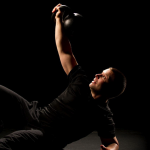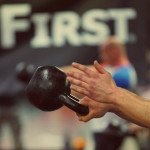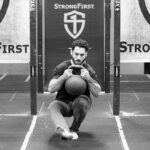What is the sound of one hand clapping? A philosophical riddle on par with: what is a one-legged kettlebell swing? And what does this have to do with “getting lateral”? Allow me to explain.
Many of our students will participate in activities that require good lateral motion, strength and stability. Think tennis, basketball, hockey etc. And most of our kettlebell drills are performed from a symmetrical stance and while there is carryover and benefit, can we add in a “spice” to the programming to assist students with better lateral performance?
Enter the “Stationary” Side-stepping Swing and Goblet Lunges!
The stationary side-stepping swing is as close to a one-legged swing as we are going to get and it is a powerful swing variation. Students will note increased eccentric load and powerful single-leg hip extension in a rhythmic fashion. Goblet lunges allow us work on the deceleration and eccentric loading found in athletic movement while performing a controlled lowering center of mass. I have found that these two together have great carryover to lateral performance and athletic movement.
The Details
Stationary Side-Stepping Swing
- Begin in a standard set-up for a two-arm kettlebell swing.
- Hike the kettlebell and begin to perform your hip extension but “fire up” to one side to fully extend one leg and come to the “standing plank” of a good kettlebell swing finish – the now “free” or unweighted leg can either tap the ground beside the stance foot or can remain off of the ground.
- As the arms are returning to the ribs step apart and down into your beginning position (standard two-arm swing set-up)—NOTE—you MUST step apart as the kettlebell comes down!
- From the hike “fire up” again but this time to the opposite side.
- Repeat for the desired number of reps alternating sides before stepping apart into the set-up position and safely “parking” the kettlebell as you would to finish any set of swings.
- Breathing is the same as any swing.
Goblet Lunges
- Begin in a standard swing set-up with both hands on the kettlebell.
- Hike the kettlebell back and as you begin to initiate hip extension you will lower your center of mass as you step back into a lunge while “pulling/shifting” the kettlebell up into the goblet rack position.
- The rear knee may gently touch the deck or hover but it cannot bang or slam down.
- Step up to return to the start position as the kettlebell drops into the hiked position to begin another rep.
- The goblet lunge can also be performed with a step forward into a lunge.
- Do not pull the kettlebell too high since you are lowering your center of mass you can think of “pulling yourself under” the kettlebell as it transitions to the goblet rack.
- Repeat for the desired repetitions and in the desired sequence or directions.
Programming
These drills are spices as I define them in my previous article, so the programming is simple.
Option 1:
Stationary side-stepping swings: Perform 6-10 stationary side-stepping swings EMOTM x 3-5 min as a way to prepare for your main ballistic or conditioning work for the day.
Goblet Lunges: Perform 2-4 goblet lunges on each leg between sets of get-ups.
Option 2:
Alternate sets of 10 stationary side-stepping swings and 4 goblet lunges each leg with full rest x 3-5 sets as an easy variety day.
Basically, you can “sprinkle” them in as they fit within the program and do not challenge any of your “main dishes.” 1-2 days a week can be sufficient to get the carryover.
Conclusion
Give these exercises a try to enhance your or your student’s lateral performance. Or just as a spice to add some specialized variety to your current routine. The stepping and movement of both drills provides increased eccentric loading, trains deceleration, and has aspects of movement variability built in since “no two steps are the same.” You will also notice an increased cardiovascular effect. Enjoy the pain…as Pavel would say.








Brett – I have been trying to think of how to train my hips for K1 sprint kayaking. No ideas until now – I think these lateral swings will be quite useful for internal hip rotation + the rest of the movement benefits from swings (tying in core, lats, upper body etc. ).
Thanks.
excellent
Keep us posted
i like the idea of hiking the bell up each time for a lunge. should make it a lot less fatiguing.
what is your take on starting with the bell at your side and then doing alternating reverse lunges while passing the bell between your legs on each rep? it requires a good deal of leg/ankle stability and i have found you can still get a lot of reps in with a 32/40kg bell. great leg accessory workout and core stability
We used to call those renegade lunges or hand to hand lunges and teach them at workshops along with other accessory drills.
They are good
Brett
Outstanding! Ive been looking for a lateral component.
Thanks Chief.
Thank you Rocky